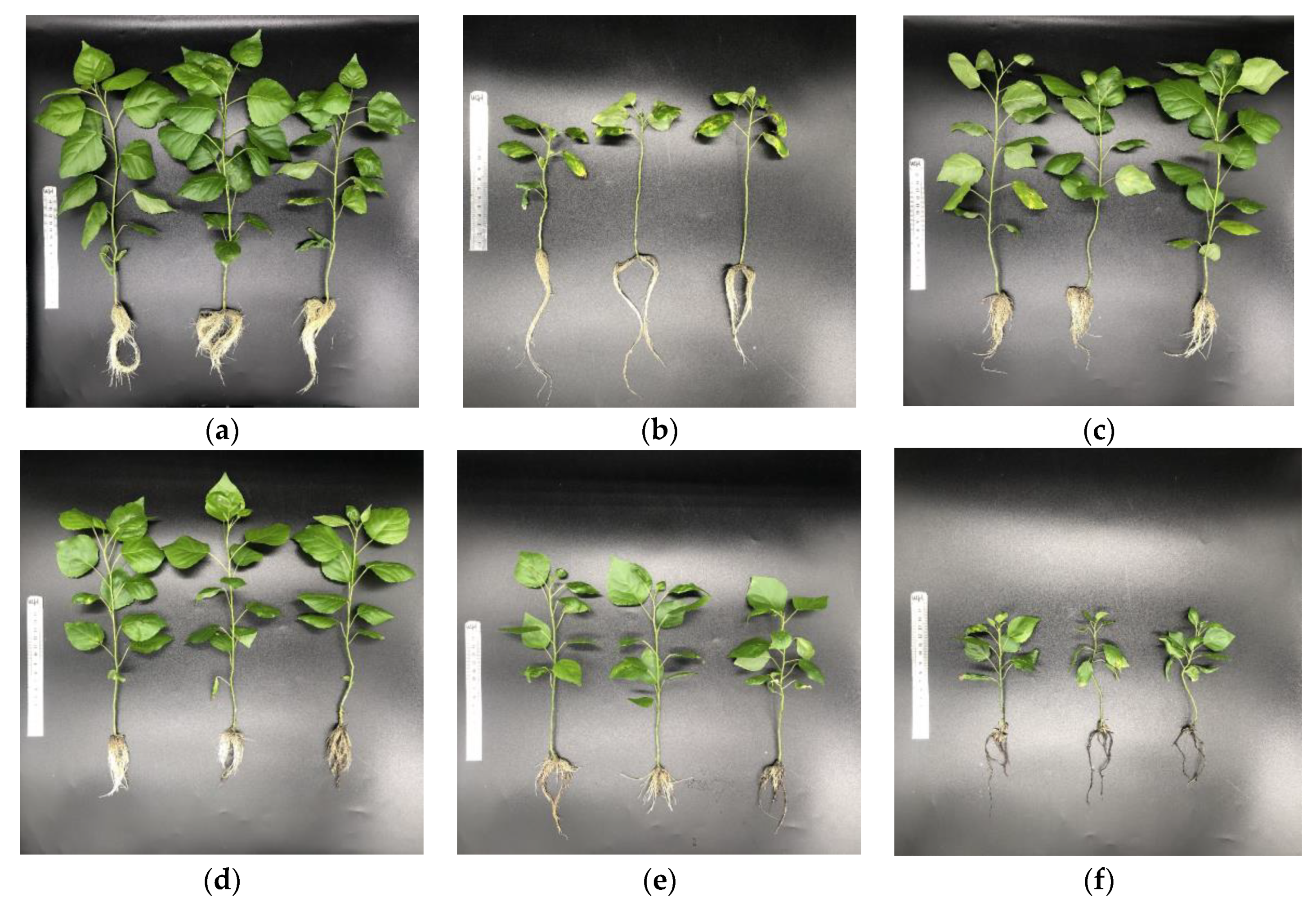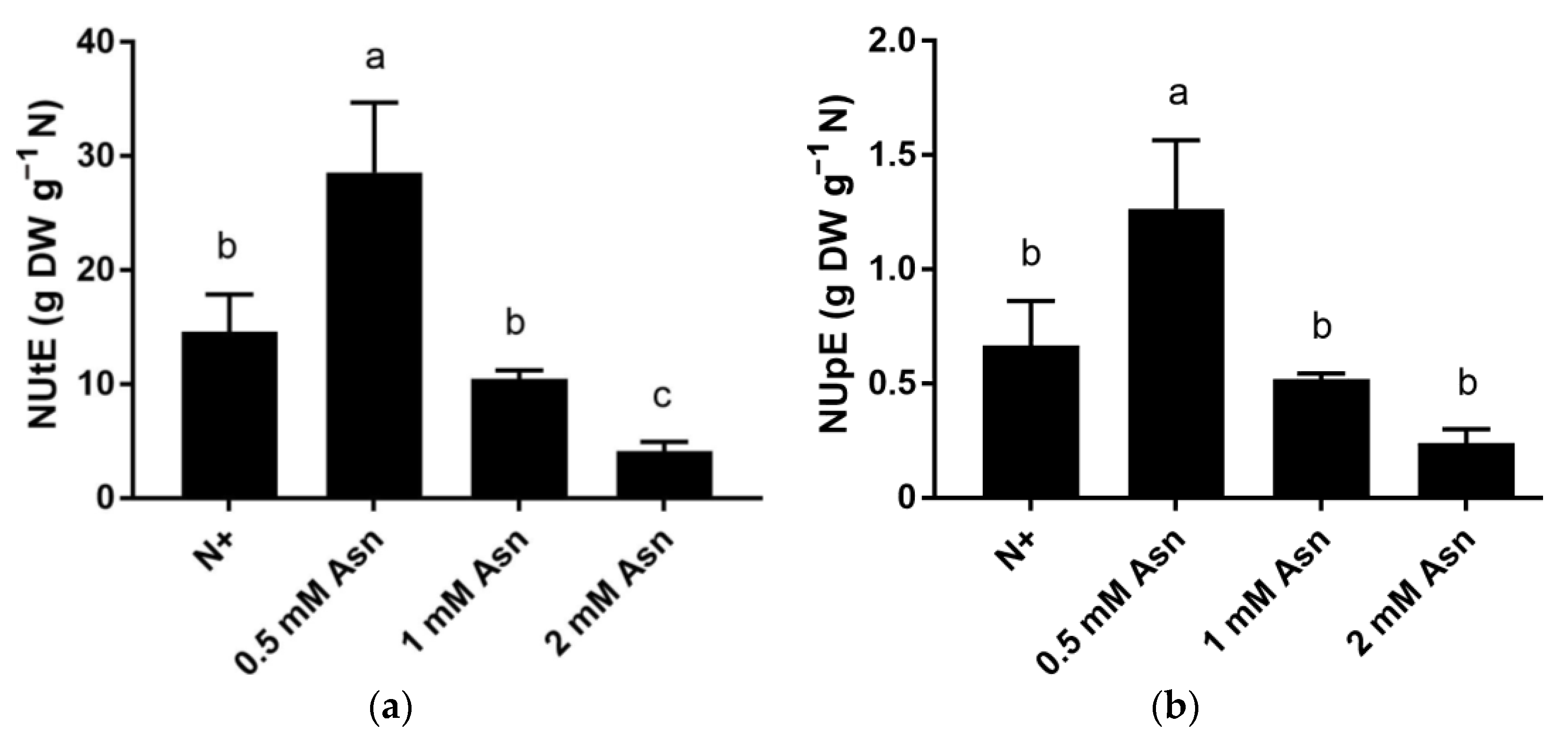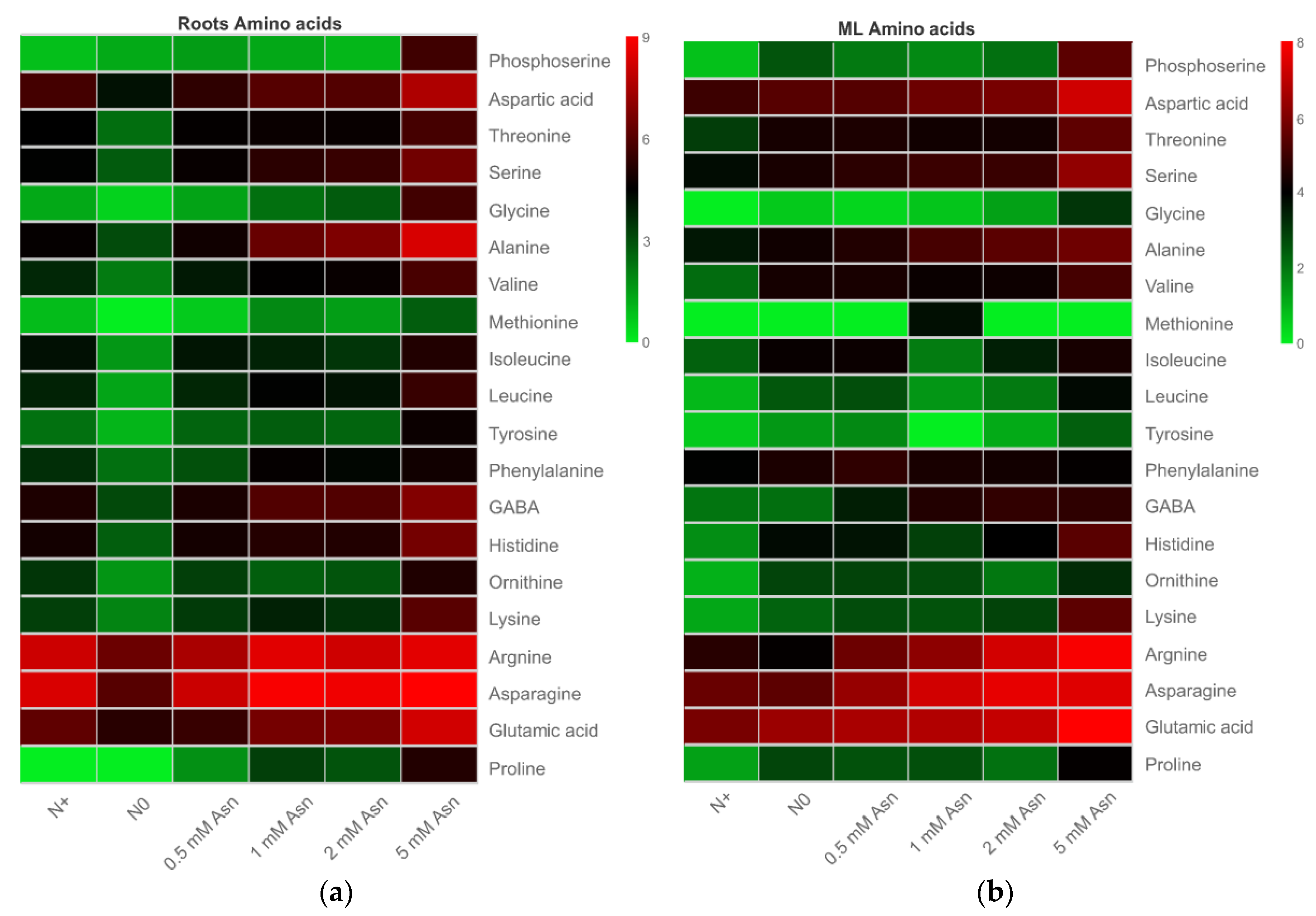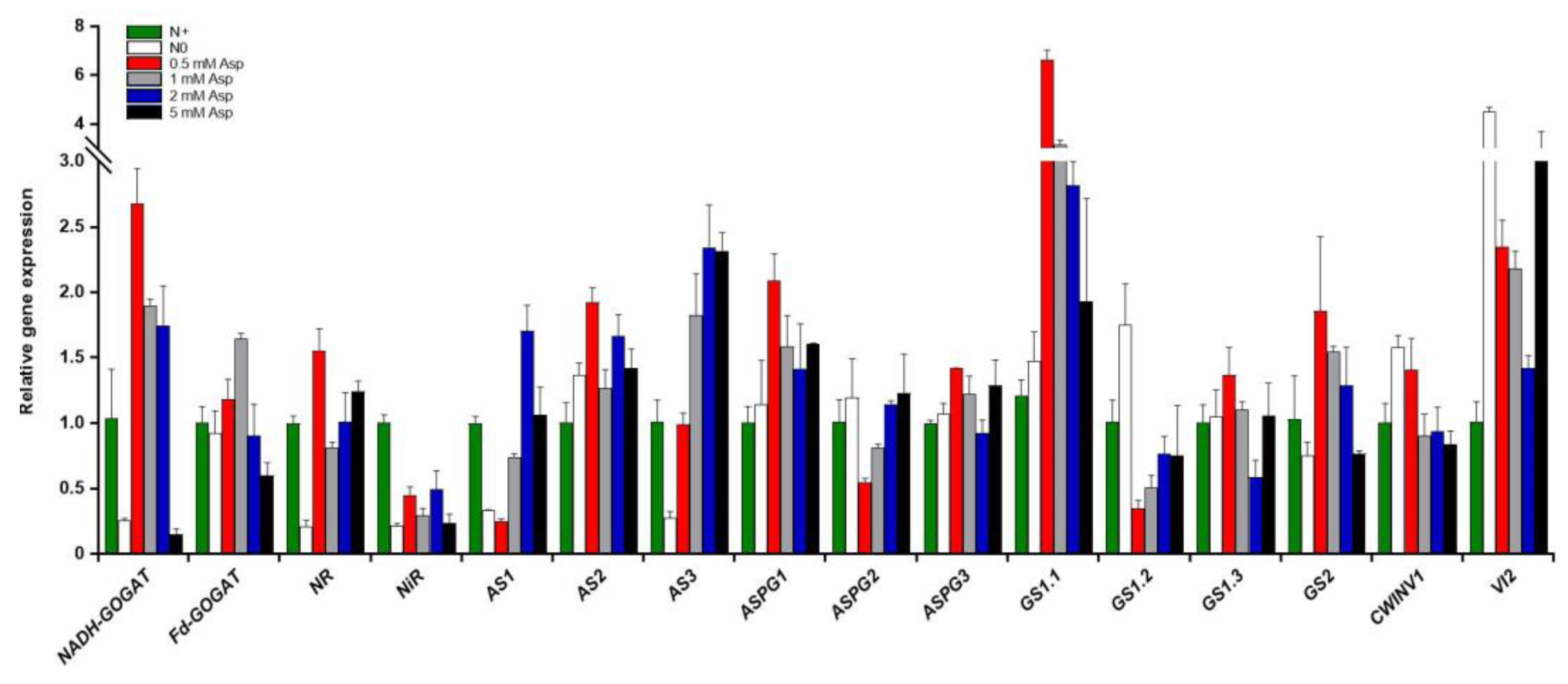Effects of Exogenous L-Asparagine on Poplar Biomass Partitioning and Root Morphology
Abstract
1. Introduction
2. Results
2.1. Exogenous Treatment of Asn Has Significant Impacts on Poplar Growth
2.2. Asn Affects Photosynthesis of Poplar
2.3. Exogenous Asn Has a Significant Influence on the Internal N Status and NUE of Poplars
2.4. Effects of Exogenous Asn on the Contents of Amino Acids
2.5. Impacts of Asn Treatment on the Expression of Genes Involved in N and C Metabolism Pathways
2.6. Impacts of Asn Treatment on Enzymes Involved in N Metabolism
3. Discussion
4. Materials and Methods
4.1. Plant Material and Growth Conditions
4.2. Analysis of Growth, Gas Exchange, and Chlorophyll Fluorescence Characteristics
4.3. Determination of Activities of Enzymes Involved in N Metabolism
4.4. Measurement of the Content of Free Amino Acids, NH4+, NO3− and NUE
4.5. Analysis of Transcript Levels of Genes Involved in N Metabolism
4.6. Statistical Analysis of Data
5. Conclusions
Supplementary Materials
Author Contributions
Funding
Institutional Review Board Statement
Informed Consent Statement
Data Availability Statement
Acknowledgments
Conflicts of Interest
References
- Tegeder, M.; Masclaux-Daubresse, C. Source and Sink Mechanisms of Nitrogen Transport and Use. New Phytol. 2018, 217, 35–53. [Google Scholar] [CrossRef] [PubMed]
- Anas, M.; Liao, F.; Verma, K.K.; Sarwar, M.A.; Mahmood, A.; Chen, Z.-L.; Li, Q.; Zeng, X.-P.; Liu, Y.; Li, Y.-R. Fate of Nitrogen in Agriculture and Environment: Agronomic, Eco-Physiological and Molecular Approaches to Improve Nitrogen Use Efficiency. Biol. Res. 2020, 53, 47. [Google Scholar] [CrossRef]
- DesRochers, A.; van den Driessche, R.; Thomas, B.R. The Interaction between Nitrogen Source, Soil PH, and Drought in the Growth and Physiology of Three Poplar Clones. Can. J. Bot. 2007, 85, 1046–1057. [Google Scholar] [CrossRef]
- Jämtgård, S.; Näsholm, T.; Huss-danell, K. Characteristics of Amino Acid Uptake in Barley. Plant Soil 2008, 302, 221–231. [Google Scholar] [CrossRef]
- Näsholm, T.; Kielland, K.; Ganeteg, U. Uptake of Organic Nitrogen by Plants. New Phytol. 2009, 182, 31–48. [Google Scholar] [CrossRef]
- Franklin, O.; Cambui, C.A.; Gruffman, L.; Palmroth, S.; Oren, R.; Näsholm, T. The Carbon Bonus of Organic Nitrogen Enhances Nitrogen Use Efficiency of Plants. Plant. Cell Environ. 2017, 40, 25–35. [Google Scholar] [CrossRef]
- Schmidt, S.; Näsholm, T.; Rentsch, D. Organic Nitrogen. New Phytol. 2014, 203, 29–31. [Google Scholar] [CrossRef]
- Jones, D.L.; Shannon, D.; Junvee-Fortune, T.; Farrar, J.F. Plant Capture of Free Amino Acids Is Maximized under High Soil Amino Acid Concentrations. Soil Biol. Biochem. 2005, 37, 179–181. [Google Scholar] [CrossRef]
- Owen, A.; Jones, D. Competition for Amino Acids between Wheat Roots and Rhizosphere Microorganisms and the Role of Amino Acids in Plant N Acquisition. Soil Biol. Biochem. 2001, 33, 651–657. [Google Scholar] [CrossRef]
- Gioseffi, E.; De Neergaard, A.; Schjoerring, J.K. Interactions between Uptake of Amino Acids and Inorganic Nitrogen in Wheat Plants. Biogeosciences 2012, 9, 1509–1518. [Google Scholar] [CrossRef]
- Ge, T.; Song, S.; Roberts, P.; Jones, D.L.; Huang, D.; Iwasaki, K. Amino Acids as a Nitrogen Source for Tomato Seedlings: The Use of Dual-Labeled (13C, 15N) Glycine to Test for Direct Uptake by Tomato Seedlings. Environ. Exp. Bot. 2009, 66, 357–361. [Google Scholar] [CrossRef]
- Paungfoo-Lonhienne, C.; Lonhienne, T.G.A.; Rentsch, D.; Robinson, N.; Christie, M.; Webb, R.I.; Gamage, H.K.; Carroll, B.J.; Schenk, P.M.; Schmidt, S. Plants Can Use Protein as a Nitrogen Source without Assistance from Other Organisms. Proc. Natl. Acad. Sci. USA 2008, 105, 4524–4529. [Google Scholar] [CrossRef] [PubMed]
- Akhtar, G.; Jaskani, M.J.; Sajjad, Y.; Akram, A. Effect of Antioxidants, Amino Acids and Plant Growth Regulators on in Vitro Propagation of Rosa Centifolia. Iran. J. Biotechnol. 2016, 14, 51–55. [Google Scholar] [CrossRef]
- Jones, D.L.; Kielland, K. Soil Amino Acid Turnover Dominates the Nitrogen flux in Permafrost-Dominated Taiga Forest Soils. Soil Biol. Biochem. 2002, 34, 209–219. [Google Scholar] [CrossRef]
- Dolev, N.; Katz, Z.; Ludmer, Z.; Ullmann, A.; Brauner, N.; Goikhman, R. Natural Amino Acids as Potential Chelators for Soil Remediation. Environ. Res. 2020, 183, 109140. [Google Scholar] [CrossRef] [PubMed]
- Garc, F.; Sim, S.; Navarro-p, V.; Alfosea-sim, M. Scientific Advances in Biostimulation Reported in the 5th Biostimulant World Congress. Horticulturae 2022, 8, 665. [Google Scholar]
- Jiao, Y.; Chen, Y.; Ma, C.; Qin, J.; Nguyen, T.H.N.; Liu, D.; Gan, H.; Ding, S.; Luo, Z.-B. Phenylalanine as a Nitrogen Source Induces Root Growth and Nitrogen-Use Efficiency in Populus × Canescens. Tree Physiol. 2018, 38, 66–82. [Google Scholar] [CrossRef] [PubMed]
- Khan, N.; Bano, A.; Rahman, M.A.; Guo, J.; Kang, Z.; Babar, M.A. Comparative Physiological and Metabolic Analysis Reveals a Complex Mechanism Involved in Drought Tolerance in Chickpea (Cicer arietinum L.) Induced by PGPR and PGRs. Sci. Rep. 2019, 9, 2097. [Google Scholar] [CrossRef]
- Kang, T.; Wu, H.D.; Lu, B.Y.; Luo, X.J.; Gong, C.M.; Bai, J. Low Concentrations of Glycine Inhibit Photorespiration and Enhance the Net Rate of Photosynthesis in Caragana Korshinskii. Photosynthetica 2018, 56, 512–519. [Google Scholar] [CrossRef]
- Rizwan, M.; Ali, S.; Zaheer Akbar, M.; Shakoor, M.B.; Mahmood, A.; Ishaque, W.; Hussain, A. Foliar Application of Aspartic Acid Lowers Cadmium Uptake and Cd-Induced Oxidative Stress in Rice under Cd Stress. Environ. Sci. Pollut. Res. 2017, 24, 21938–21947. [Google Scholar] [CrossRef]
- Sadak, M.S.H.; Abdelhamid, M.T.; Schmidhalter, U. Effect of Foliar Application of Amino Acids on Plant Yield and Some Physiological Parameters in Bean Palnts Irrigated with Seawater. Acta Biol. Colomb. 2015, 20, 141–152. [Google Scholar]
- Geshnizjani, N.; Khosh-khui, M. Promoted Growth and Improved Quality of Gerbera Jamesonni L. Flowers Using Exogenous Application of Amino Acids. Int. J. Hortic. Sci. Technol. 2016, 3, 155–166. [Google Scholar] [CrossRef]
- Akladious, S.A.; Abbas, S.M. Alleviation of Sea Water Stress on Tomato Plants by Foliar Application of Aspartic Acid and Glutathione. Bangladesh J. Bot. 2013, 42, 31–43. [Google Scholar] [CrossRef]
- Abd El-samad, H.M.; Shaddad, M.A.K.; Barakat, N. Improvement of Plants Salt Tolerance by Exogenous Application of Amino Acids. J. Med. Plants Res. 2011, 5, 5692–5699. [Google Scholar]
- Kan, C.; Chung, T.; Juo, Y.; Hsieh, M. Glutamine Rapidly Induces the Expression of Key Transcription Factor Genes Involved in Nitrogen and Stress Responses in Rice Roots. BMC Genomics 2015, 16, 731. [Google Scholar] [CrossRef] [PubMed]
- Hassan, M.U.; Islam, M.M.; Wang, R.; Guo, J.; Luo, H.; Chen, F.; Li, X. Glutamine Application Promotes Nitrogen and Biomass Accumulation in the Shoot of Seedlings of the Maize Hybrid ZD958. Planta 2020, 251, 66. [Google Scholar] [CrossRef]
- Ali, Q.; Athar, H.-R.; Haider, M.Z.; Shahid, S.; Aslam, N.; Shehzad, F.; Naseem, J.; Ashraf, R.; Ali, A.; Hussain, S.M. Role of Amino Acids in Improving Abiotic Stress Tolerance to Plants. In Plant Tolerance to Environmental Stress; CRC Press: Boca Raton, FL, USA, 2019; pp. 175–204. ISBN 9780203705315. [Google Scholar]
- Brouquisse, R.; James, F.; Pradet, A.; Raymond, P. Asparagine Metabolism and Nitrogen Distribution during Protein Degradation in Sugar-Starved Maize Root Tips. Planta 1992, 188, 384–395. [Google Scholar] [CrossRef] [PubMed]
- Gaufichon, L.; Reisdorf-Cren, M.; Rothstein, S.J.; Chardon, F.; Suzuki, A. Biological Functions of Asparagine Synthetase in Plants. Plant Sci. 2010, 179, 141–153. [Google Scholar] [CrossRef]
- Mansfeld, J.; Gebauer, S.; Dathe, K.; Ulbrich-Hofmann, R. Secretory Phospholipase A2 from Arabidopsis Thaliana: Insights into the Three-Dimensional Structure and the Amino Acids Involved in Catalysis. Biochemistry 2006, 45, 5687–5694. [Google Scholar] [CrossRef]
- Gaufichon, L.; Rothstein, S.J.; Suzuki, A. Asparagine Metabolic Pathways in Arabidopsis. Plant Cell Physiol. 2016, 57, 675–689. [Google Scholar] [CrossRef]
- Coruzzi, G.M. Primary N-Assimilation into Amino Acids in Arabidopsis. In The Arabidopsis Book; American Society of Plant Biologists: Rockville, MD, USA, 2003; Volume 2, p. e0010. ISBN 1543-8120. [Google Scholar]
- Lea, P.J.; Sodek, L.; Parry, M.A.J.; Shewry, P.R.; Halford, N.G. Asparagine in Plants. Ann. Appl. Biol. 2007, 150, 1–26. [Google Scholar] [CrossRef]
- Pant, A.; Yang, Z. Asparagine: An Achilles Heel of Virus Replication? ACS Infect. Dis. 2020, 6, 2301–2303. [Google Scholar] [CrossRef] [PubMed]
- Jiang, J.; Pavlova, N.N.; Zhang, J. Asparagine, a Critical Limiting Metabolite during Glutamine Starvation. Mol. Cell. Oncol. 2018, 5, e1441633. [Google Scholar] [CrossRef] [PubMed]
- Krall, A.S.; Xu, S.; Graeber, T.G.; Braas, D.; Christofk, H.R. Asparagine Promotes Cancer Cell Proliferation through Use as an Amino Acid Exchange Factor. Nat. Commun. 2016, 7, 11457. [Google Scholar] [CrossRef] [PubMed]
- Aidar, M.P.M.; Schmidt, S.; Moss, G.; Stewart, G.R.; Joly, C.A. Nitrogen Use Strategies of Neotropical Rainforest Trees in Threatened Atlantic Forest. Plant Cell Environ. 2003, 26, 389–399. [Google Scholar] [CrossRef]
- Lin, J.F.; Wu, S.H. Molecular Events in Senescing Arabidopsis Leaves. Plant J. 2004, 39, 612–628. [Google Scholar] [CrossRef]
- Sulieman, S.; Tran, L.S.P. Asparagine: An Amide of Particular Distinction in the Regulation of Symbiotic Nitrogen Fixation of Legumes. Crit. Rev. Biotechnol. 2013, 33, 309–327. [Google Scholar] [CrossRef]
- Rashmi, D.; Barvkar, V.T.; Nadaf, A.; Mundhe, S.; Kadoo, N.Y. Integrative Omics Analysis in Pandanus Odorifer (Forssk.) Kuntze Reveals the Role of Asparagine Synthetase in Salinity Tolerance. Sci. Rep. 2019, 9, 932. [Google Scholar] [CrossRef]
- Oddy, J.; Raffan, S.; Wilkinson, M.D.; Elmore, J.S.; Halford, N.G. Stress, Nutrients and Genotype: Understanding and Managing Asparagine Accumulation in Wheat Grain. CABI Agric. Biosci. 2020, 1, 10. [Google Scholar] [CrossRef]
- Hwang, I.S.; An, S.H.; Hwang, B.K. Pepper Asparagine Synthetase 1 (CaAS1) Is Required for Plant Nitrogen Assimilation and Defense Responses to Microbial Pathogens. Plant J. 2011, 67, 749–762. [Google Scholar] [CrossRef]
- Kaya, C.; Aydemir, S.; Sonmez, O.; Ashraf, M.; Dikilitas, M. Regulation of Growth and Some Key Physiological Processes in Salt-Stressed Maize (Zea mays L.) Plants by Exogenous Application of Asparagine and Glycerol. Acta Bot. Croat. 2013, 72, 157–168. [Google Scholar] [CrossRef]
- Ivanov, A.; Kameka, A.; Pajak, A.; Bruneau, L.; Beyaert, R.; Hernández-Sebastià, C.; Marsolais, F. Arabidopsis Mutants Lacking Asparaginases Develop Normally but Exhibit Enhanced Root Inhibition by Exogenous Asparagine. Amino Acids 2012, 42, 2307–2318. [Google Scholar] [CrossRef] [PubMed]
- Sarropoulou, V.; Chatzissavvidis, C.; Dimassi-Theriou, K.; Therios, I. Effect of Asparagine, Cysteine, Citrulline, and Glutamine on in Vitro Rooting and Biochemical Constituents in Cherry Rootstocks. Biol. Plant. 2016, 60, 1–12. [Google Scholar] [CrossRef]
- Sarker, K.; Kabir, A.; Sharmin, S.; Nasrin, Z.; Alam, M. Improved Somatic Embryogenesis Using L-Asparagine in Wheat (Triticum aestivum L.). Sjemenarstvo 2007, 24, 187–196. [Google Scholar]
- Haroun, S.A.; Shukry, W.M.; El-Sawy, O. Effect of Asparagine or Glutamine on Growth and Metabolic Changes in Phaseolus Vulgaris under in Vitro Conditions. Biosci. Res. 2010, 7, 1–21. [Google Scholar]
- Jorkesh, A.; Aminifard, M.H. Foliar Application of Asparagine and Casein on Biochemical and Morphological Attributes of Garden Cress (Lepidium sativum L.) under Greenhouse Conditions. Adv. Hortic. Sci. 2019, 33, 227–233. [Google Scholar] [CrossRef]
- Moigne, M.L.; Guérin, V.; Furet, P.; Billard, V.; Lebrec, A.; Roman, H.; Citerne, S.; Morvan-bertrand, A.; Limami, A.; Vian, A.; et al. Asparagine and Sugars Are Both Required to Sustain Secondary Axis Elongation after Bud Outgrowth in Rosa Hybrida. J. Plant Physiol. 2018, 222, 17–27. [Google Scholar] [CrossRef]
- Cooke, J.E.K.; Martin, T.A.; Davis, J.M. Short-Term Physiological and Developmental Responses to Nitrogen Availability in Hybrid Poplar. New Phytol. 2005, 167, 41–52. [Google Scholar] [CrossRef]
- Luo, J.; Zhou, J.; Masclaux-Daubresse, C.; Wang, N.; Wang, H.; Zheng, B. Morphological and Physiological Responses to Contrasting Nitrogen Regimes in Populus Cathayana Is Linked to Resources Allocation and Carbon/Nitrogen Partition. Environ. Exp. Bot. 2019, 162, 247–255. [Google Scholar] [CrossRef]
- Qu, C.; Hao, B.; Xu, X.; Wang, Y.; Yang, C.; Xu, Z.; Liu, G. Functional Research on Three Presumed Asparagine Synthetase Family Members in Poplar. Genes 2019, 10, 326. [Google Scholar] [CrossRef]
- Han, M.; Xu, M.; Wang, S.; Wu, L.; Sun, S.; Su, T. Effects of Exogenous L-Glutamine as a Sole Nitrogen Source on Physiological Characteristics and Nitrogen Use Efficiency of Poplar. Plant Physiol. Biochem. 2022, 172, 1–13. [Google Scholar] [CrossRef] [PubMed]
- Finzi, A.C.; Berthrong, S.T. The Uptake of Amino Acids by Microbes and Trees in Three Cold-Temperate Forests. Ecology 2005, 86, 3345–3353. [Google Scholar] [CrossRef]
- Bassi, D.; Menossi, M.; Mattiello, L. Nitrogen Supply Influences Photosynthesis Establishment along the Sugarcane Leaf. Sci. Rep. 2018, 8, 2327. [Google Scholar] [CrossRef] [PubMed]
- Falkowski, P.G.; Lin, H.; Gorbunov, M.Y. What Limits Photosynthetic Energy Conversion Efficiency in Nature? Lessons from the Oceans. Philos. Trans. R. Soc. B Biol. Sci. 2017, 372, 20160376. [Google Scholar] [CrossRef]
- Zhu, X.-G.; Long, S.P.; Ort, D.R. What Is the Maximum Efficiency with Which Photosynthesis Can Convert Solar Energy into Biomass? Curr. Opin. Biotechnol. 2008, 19, 153–159. [Google Scholar] [CrossRef]
- Ruban, A.V. Nonphotochemical Chlorophyll Fluorescence Quenching: Mechanism and Effectiveness in Protecting Plants from Photodamage. Plant Physiol. 2016, 170, 1903–1916. [Google Scholar] [CrossRef]
- Ireland, R.J.; Joy, K.W. Two Routes for Asparagine Metabolism in Pisum sativum L. Planta 1981, 151, 289–292. [Google Scholar] [CrossRef]
- Tiwari, J.K.; Devi, S.; Buckseth, T.; Ali, N.; Singh, R.K.; Zinta, R.; Dua, V.K.; Chakrabarti, S.K. Precision Phenotyping of Contrasting Potato (Solanum tuberosum L.) Varieties in a Novel Aeroponics System for Improving Nitrogen Use Efficiency: In Search of Key Traits and Genes. J. Integr. Agric. 2020, 19, 51–61. [Google Scholar] [CrossRef]
- Pandey, A.; Devi, L.L.; Singh, A.P. Review: Emerging Roles of Brassinosteroid in Nutrient Foraging. Plant Sci. 2020, 296, 110474. [Google Scholar] [CrossRef]
- Wan, H.; Wu, L.; Yang, Y.; Zhou, G.; Ruan, Y.-L. Evolution of Sucrose Metabolism: The Dichotomy of Invertases and Beyond. Trends Plant Sci. 2018, 23, 163–177. [Google Scholar] [CrossRef]
- Xu, H.; Curtis, T.Y.; Powers, S.J.; Raffan, S.; Gao, R.; Huang, J.; Heiner, M.; Gilbert, D.R.; Halford, N.G. Genomic, Biochemical, and Modeling Analyses of Asparagine Synthetases from Wheat. Front. Plant Sci. 2018, 8, 1–12. [Google Scholar] [CrossRef]
- Ta, T.C.; Joy, K.W.; Ireland, R. Role of Asparagine in the Photochemistry Nitrogen Metaboliem of Pea Leaves. Plant Physiol. 1985, 78, 334–337. [Google Scholar] [CrossRef] [PubMed]
- Sharma, D.; Yu, Y.; Shen, L.; Zhang, G.-F.; Karner, C.M. SLC1A5 Provides Glutamine and Asparagine Necessary for Bone Development in Mice. Elife 2021, 10, e71595. [Google Scholar] [CrossRef] [PubMed]
- Forsum, O.; Svennerstam, H.; Ganeteg, U. Capacities and Constraints of Amino Acid Utilization in Arabidopsis. New Phytol. 2008, 179, 1058–1069. [Google Scholar] [CrossRef] [PubMed]
- Mills, S. Potential of Exogenous L-Amino Acids in Salinity Stress Alleviation during Germination and Early Post-Germinative Seedling Growth of Lactuca sativa L.; University of Canterbury: Christchurch, New Zealand, 2014. [Google Scholar]
- Yoneyama, T.; Suzuki, A. Light-Independent Nitrogen Assimilation in Plant Leaves: Nitrate Incorporation into Glutamine, Glutamate, Aspartate, and Asparagine Traced By15n. Plants 2020, 9, 1303. [Google Scholar] [CrossRef]
- Ehlting, B.; Dluzniewska, P.; Dietrich, H.; Selle, A.; Teuber, M.; Hansch, R.; Nehls, U.; Polle, A.; Schnitzler, J.-P.; Rennenberg, H.; et al. Interaction of Nitrogen Nutrition and Salinity in Grey Poplar (Populus tremula × alba). Plant. Cell Environ. 2007, 30, 796–811. [Google Scholar] [CrossRef]
- Teixeira, W.F.; Fagan, E.B.; Soares, L.H.; Soares, J.N.; Reichardt, K.; Neto, D.D. Seed and Foliar Application of Amino Acids Improve Variables of Nitrogen Metabolism and Productivity in Soybean Crop. Front. Plant Sci. 2018, 9, 396. [Google Scholar] [CrossRef]
- Postles, J.; Curtis, T.Y.; Powers, S.J.; Elmore, J.S.; Mottram, D.S.; Halford, N.G. Changes in Free Amino Acid Concentration in Rye Grain in Response to Nitrogen and Sulfur Availability, and Expression Analysis of Genes Involved in Asparagine Metabolism. Front. Plant Sci. 2016, 7, 917. [Google Scholar] [CrossRef]
- Kanamori, T.; Matsumoto, H. Asparagine Biosynthesis by Oryza Sativa Seedlings. Phytochemistry 1974, 13, 1407–1412. [Google Scholar] [CrossRef]
- Winter, G.; Todd, C.D.; Trovato, M.; Forlani, G.; Funck, D. Physiological Implications of Arginine Metabolism in Plants. Front. Plant Sci. 2015, 6, 534. [Google Scholar] [CrossRef]
- Bown, A.W.; Shelp, B.J. Plant GABA: Not Just a Metabolite. Trends Plant Sci. 2016, 21, 811–813. [Google Scholar] [CrossRef] [PubMed]
- Zhang, J.; Fan, J.; Venneti, S.; Cross, J.R.; Takagi, T.; Bhinder, B.; Djaballah, H.; Kanai, M.; Cheng, E.H.; Judkins, A.R.; et al. Asparagine Plays a Critical Role in Regulating Cellular Adaptation to Glutamine Depletion. Mol. Cell 2014, 56, 205–218. [Google Scholar] [CrossRef] [PubMed]
- Jiang, J.; Batra, S.; Zhang, J. Asparagine: A Metabolite to Be Targeted in Cancers. Metabolites 2021, 11, 402. [Google Scholar] [CrossRef]
- Genix, P.; Bligny, R.; Martin, J.B.; Douce, R. Transient Accumulation of Asparagine in Sycamore Cells after a Long Period of Sucrose Starvation. Plant Physiol. 1990, 94, 717–722. [Google Scholar] [CrossRef]
- Zhang, Y.; Wang, Y.; Kanyuka, K.; Parry, M.A.J.; Powers, S.J.; Halford, N.G. GCN2-Dependent Phosphorylation of Eukaryotic Translation Initiation Factor-2α in Arabidopsis. J. Exp. Bot. 2008, 59, 3131–3141. [Google Scholar] [CrossRef] [PubMed]
- Lin, C.C.; Kao, C.H. Disturbed Ammonium Assimilation Is Associated with Growth Inhibition of Roots in Rice Seedlings Caused by NaCl. Plant Growth Regul. 1996, 18, 233–238. [Google Scholar] [CrossRef]
- Gan, H.; Jiao, Y.; Jia, J.; Wang, X.; Li, H.; Shi, W.; Peng, C.; Polle, A.; Luo, Z. Bin Phosphorus and Nitrogen Physiology of Two Contrasting Poplar Genotypes When Exposed to Phosphorus and/or Nitrogen Starvation. Tree Physiol. 2015, 36, 22–38. [Google Scholar] [CrossRef]
- Liao, Y.; Cui, R.; Yuan, T.; Xie, Y.; Gao, Y. Cysteine and Methionine Contribute Differentially to Regulate Alternative Oxidase in Leaves of Poplar (Populus Deltoides x Populus Euramericana ‘Nanlin 895’) Seedlings Exposed to Different Salinity. J. Plant Physiol. 2019, 240, 153017. [Google Scholar] [CrossRef]
- Ying, X. Determination of Trace Ammonia Content in Water by Ninhydrin Colorinetry. Chem. Fertil. Ind. 2011, 38, 27–30. [Google Scholar]
- Patterson, K.; Cakmak, T.; Cooper, A.; Lager, I.; Rasmusson, A.G.; Escobar, M.A. Distinct Signalling Pathways and Transcriptome Response Signatures Differentiate Ammonium- and Nitrate-Supplied Plants. Plant Cell Environ. 2010, 33, 1486–1501. [Google Scholar] [CrossRef]
- Good, A.G.; Shrawat, A.K.; Muench, D.G. Can Less Yield More? Is Reducing Nutrient Input into the Environment Compatible with Maintaining Crop Production? Trends Plant Sci. 2004, 9, 597–605. [Google Scholar] [CrossRef] [PubMed]
- Lonhienne, T.G.A.; Trusov, Y.; Young, A.; Rentsch, D.; Näsholm, T.; Schmidt, S.; Paungfoo-Lonhienne, C. Effects of Externally Supplied Protein on Root Morphology and Biomass Allocation in Arabidopsis. Sci. Rep. 2014, 4, 5505. [Google Scholar] [CrossRef] [PubMed]








| Treatment | Height (cm) | Root Length (cm) | Shoot FW (g) | Root FW (g) | Number of Blades | Leaf Area (mm2) | Root–Shoot Ratio |
|---|---|---|---|---|---|---|---|
| N+ | 30.767 ± 2.926 a | 16.467 ± 4.563 a | 6.115 ± 1.589 a | 2.068 ± 0.356 a | 14.333 ± 0.577 a | 1562.667 ± 483.514 a | 0.348 ± 0.083 b |
| N0 | 16.275 ± 2.837 de | 17.7 ± 3.403 a | 1.301 ± 0.599 e | 0.845 ± 0.298 b | 7 ± 0.816 d | 723.267 ± 429.444 b | 0.671 ± 0.076 a |
| 0.5 mM Asn | 26.8 ± 2.342 b | 10.975 ± 3.2 b | 3.916 ± 1.236 b | 0.943 ± 0.208 b | 13 ± 1.826 ab | 1676.667 ± 529.802 a | 0.255 ± 0.08 b |
| 1 mM Asn | 23.333 ± 2.307 bc | 9.5 ± 0.5 b | 3.016 ± 0.259 bc | 0.881 ± 0.052 b | 11.333 ± 1.155 bc | 1018.5 ± 105.194 ab | 0.293 ± 0.022 b |
| 2 mM Asn | 19.85 ± 2.029 cd | 8.075 ± 2.329 b | 2.12 ± 0.345 cd | 0.723 ± 0.165 b | 10.75 ± 0.5 c | 886 ± 542.769 ab | 0.339 ± 0.025 b |
| 5 mM Asn | 12.533 ± 0.551 e | 11.533 ± 1.858 b | 1.023 ± 0.207 e | 0.319 ± 0.042 c | 8.667 ± 0.577 d | 511.4 ± 237.216 b | 0.32 ± 0.076 b |
| Treatment | Pn (μmol CO2·m−2·s−1) | gs (mol·m−2·s−1) | Ci (μmol·mol−1) | Tr (mmol H2O·m−2·s−1) |
|---|---|---|---|---|
| N+ | 8.095 ± 0.533 a | 0.152 ± 0.033 a | 320.2 ± 14.306 a | 1.468 ± 0.254 a |
| N0 | 2.318 ± 0.299 f | 0.023 ± 0.001 f | 262.5 ± 22.708 c | 0.258 ± 0.014 e |
| 0.5 mM Asn | 5.225 ± 1.044 c | 0.070 ± 0.027 d | 287.75 ± 22.248 b | 0.726 ± 0.260 d |
| 1 mM Asn | 6.103 ± 0.101 b | 0.149 ± 0.008 b | 316.5 ± 5.196 a | 1.375 ± 0.064 b |
| 2 mM Asn | 4.673 ± 0.702 d | 0.079 ± 0.018 c | 314.75 ± 7.411 a | 0.846 ± 0.190 c |
| 5 mM Asn | 3.428 ± 0.107 e | 0.053 ± 0.029 e | 256.75 ± 45.339 c | 0.383 ± 0.071 e |
| Treatment | Fv/Fm | NPQ | Fv’/Fm’ | qP | ΦPSⅡ | Fv/Fo |
|---|---|---|---|---|---|---|
| N+ | 0.783 ± 0.008 a | 0.936 ± 0.424 ab | 0.66 ± 0.02 abc | 0.469 ± 0.057 a | 0.307 ± 0.01 a | 3.652 ± 0.161 a |
| N0 | 0.781 ± 0.003 a | 1.065 ± 0.053 a | 0.635 ± 0.008 c | 0.486 ± 0.018 a | 0.308 ± 0.01 a | 3.606 ± 0.07 a |
| 0.5 mM Asn | 0.773 ± 0.008 a | 0.569 ± 0.059 bc | 0.688 ± 0.02 abc | 0.411 ± 0.014 ab | 0.283 ± 0.002 bc | 3.478 ± 0.436 a |
| 1 mM Asn | 0.79 ± 0.008 a | 0.482 ± 0.08 bc | 0.717 ± 0.017 ab | 0.374 ± 0.014 c | 0.268 ± 0.007 c | 3.798 ± 0.183 a |
| 2 mM Asn | 0.741 ± 0.028 b | 0.584 ± 0.171 bc | 0.648 ± 0.052 bc | 0.433 ± 0.053 ab | 0.278 ± 0.012 bc | 2.918 ± 0.42 b |
| 5 mM Asn | 0.793 ± 0.007 a | 0.432 ± 0.38 c | 0.73 ± 0.043 a | 0.372 ± 0.077 c | 0.269 ± 0.037 c | 3.877 ± 0.155 a |
Publisher’s Note: MDPI stays neutral with regard to jurisdictional claims in published maps and institutional affiliations. |
© 2022 by the authors. Licensee MDPI, Basel, Switzerland. This article is an open access article distributed under the terms and conditions of the Creative Commons Attribution (CC BY) license (https://creativecommons.org/licenses/by/4.0/).
Share and Cite
Han, M.; Wang, S.; Wu, L.; Feng, J.; Si, Y.; Liu, X.; Su, T. Effects of Exogenous L-Asparagine on Poplar Biomass Partitioning and Root Morphology. Int. J. Mol. Sci. 2022, 23, 13126. https://doi.org/10.3390/ijms232113126
Han M, Wang S, Wu L, Feng J, Si Y, Liu X, Su T. Effects of Exogenous L-Asparagine on Poplar Biomass Partitioning and Root Morphology. International Journal of Molecular Sciences. 2022; 23(21):13126. https://doi.org/10.3390/ijms232113126
Chicago/Turabian StyleHan, Mei, Shizhen Wang, Liangdan Wu, Junhu Feng, Yujia Si, Xiaoning Liu, and Tao Su. 2022. "Effects of Exogenous L-Asparagine on Poplar Biomass Partitioning and Root Morphology" International Journal of Molecular Sciences 23, no. 21: 13126. https://doi.org/10.3390/ijms232113126
APA StyleHan, M., Wang, S., Wu, L., Feng, J., Si, Y., Liu, X., & Su, T. (2022). Effects of Exogenous L-Asparagine on Poplar Biomass Partitioning and Root Morphology. International Journal of Molecular Sciences, 23(21), 13126. https://doi.org/10.3390/ijms232113126







